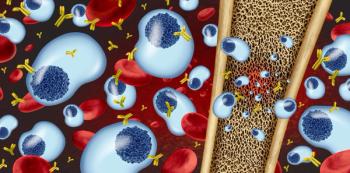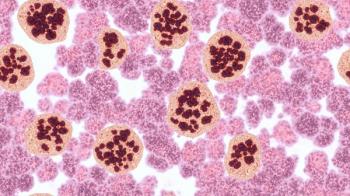
CHEST 2025: Brensocatib Shows Potential to Slow Structural Lung Changes in Bronchiectasis
James Chalmers, MBChB, PhD, discusses the ASPEN trial's findings on brensocatib's impact on lung structure and function in bronchiectasis patients.
In an interview with Pharmacy Times®, James Chalmers, MBChB, PhD, a professor of respiratory medicine at the University of Dundee in Scotland, discussed findings from the ASPEN trial evaluating the effects of brensocatib (Brinsupri; Insmed Incorporated) on structural lung changes observed through CT imaging in patients with non-cystic fibrosis bronchiectasis.
During his session at CHEST 2025, held October 19-22 in Chicago, Illinois, Chalmers explained how CT outcomes provide insight into disease progression, the anti-inflammatory impact of brensocatib, and how these imaging results may correlate with improvements in lung function and reduced exacerbation rates.
Pharmacy Times: What was the goal of evaluating brensocatib’s effects on CT outcomes in the ASPEN trial?
James Chalmers, MBChB, PhD: One of the most important outcomes for patients—and the most important outcome for us as clinicians caring for patients—is, are our patients going to get worse over time? And are there any treatments that we can use to stop patients from deteriorating over time?
Bronchiectasis is a disease defined by radiology—permanent dilation of the airways on CT—and so the best way to evaluate progression of disease over time is with CT. The purpose of the CT substudy within the ASPEN trial was to answer the question: could brensocatib slow the progression of the disease as measured by features on CT?
Pharmacy Times: What key imaging or structural changes were observed among patients treated with brensocatib?
Chalmers: The CT substudy evaluated, in the end, 100 patients who had paired before-treatment and after-treatment 52-week CT scans. There were two methods used to look at the CTs.
One was the BEST CT score, which is a grid-based scoring system used to evaluate multiple different features on the CT. The most important features I’m going to talk about are the dilation of the airways—bronchiectasis—and mucus plugging, which is one of the key markers of disease activity.
There was also a second method used, which was scoring of the bronchial arterial ratio, and I’ll mention that briefly at the end of what I’m about to say. But the key features I’m going to talk about are really on the BEST CT score.
What we saw were significant changes in mucus plugging in bronchiectasis airways, particularly with the 25 mg dose versus placebo. That suggests that in those damaged airways, which are often blocked with mucus, brensocatib was reducing that mucus plugging through its anti-inflammatory effect.
We also saw, in unaffected airways—what appeared to be healthy, non-bronchiectasis airways—a significant reduction in mucus plugging. That’s really interesting because we know that those airways can be affected by mucus plugging, and we saw that with the 25 mg dose, there was also a significant reduction in mucus plugging in those airways.
There was also an effect on bronchiectasis without mucus plugging—those are dilated airways—with the 10 mg dose versus placebo. A number of these changes were observed. It must be stated that this is a small substudy within a much larger study, so the findings need to be treated with caution, but they indicate the potential, particularly for a large effect on mucus, and overall, an effect on the structural changes that we see on CT that could be very important clinically.
There was also a method used to look at the bronchial arterial ratio—a machine learning artificial intelligence method—that also showed changes consistent with an effect of brensocatib on structural changes in the airways.
Taking all that together, these data support what we’ve seen in other measures, including biomarker measures—that the anti-inflammatory effect of brensocatib is having an effect on mucus, which is incredibly important to patients and may also be slowing the progression of the disease. That’s potentially a very important finding.
Pharmacy Times: How do these CT findings correlate with clinical outcomes such as exacerbation rates or lung function?
Chalmers: In the overall ASPEN trial, as you may be aware, in over 1700 patients, brensocatib at both the 10 mg and the 25 mg dose reduced the frequency of exacerbations by approximately 20%, and the 25 mg dose also slowed the rate of decline in lung function.
The CT features—the mucus plugging endpoints in particular—aligning with that benefit of the 25 mg on lung function, suggest that one of the ways in which brensocatib may be slowing lung function decline is by clearing mucus and therefore unblocking those airways that are affected by mucus.
We’ve conducted some previous research in my group in the European consortium called EMBARC, looking at this BEST CT scoring system and showing that those changes we see on that scoring system are associated with worse lung function, more severe disease, and exacerbations.
Taking all that together, it suggests that one of the mechanisms by which brensocatib is reducing exacerbations and improving lung function—particularly at the 25 mg dose—may be through unblocking airways that are affected by mucus.
Pharmacy Times: How might these findings influence future research or treatment strategies for this patient population?
Chalmers: I think it challenges us to start to think about treatments differently. Our traditional way of looking at treatments is: I’m going to give this drug with the hope of reducing the exacerbation frequency of the patient, and that’s a temporary fix. We’re going to try to reduce the burden of this disease on this patient.
But until these data, and until the lung function data in ASPEN, we’ve not really had a method of slowing down the progression of disease. Bronchiectasis is a progressive disease, so I think this now challenges us to start thinking about treatment differently and to ask: should we be treating patients at an earlier stage and trying to prevent lung function, CT changes, and other measures of disease severity from getting worse over time?
That’s what patients want. Patients want us to be giving long-term treatments that keep them healthier for longer.
Newsletter
Stay informed on drug updates, treatment guidelines, and pharmacy practice trends—subscribe to Pharmacy Times for weekly clinical insights.



















































































































































































































